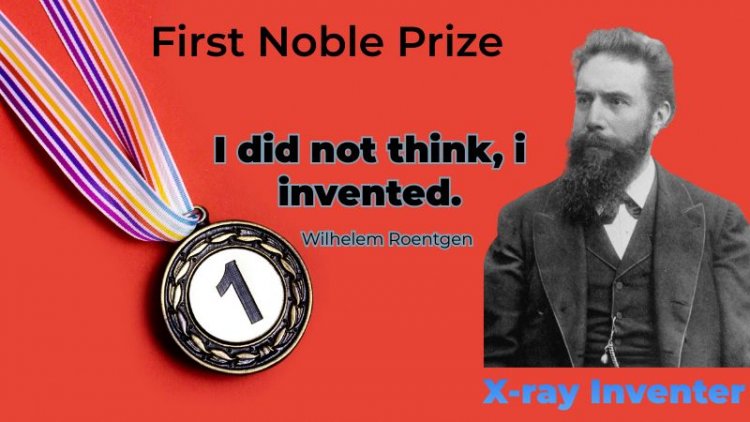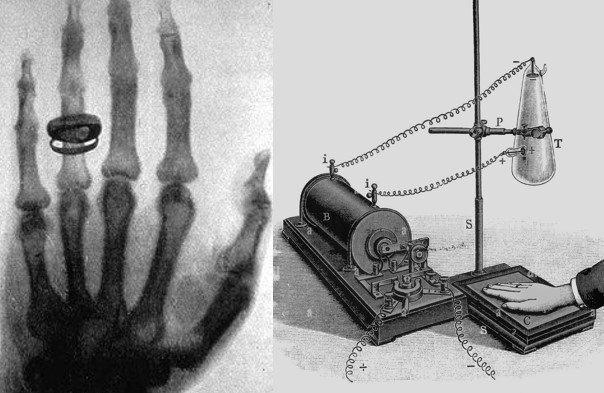Physics First Noble Prize
Wilhelm Rontgen, the German scientist, discovered X-rays, and revolutionized medicine and radiodiagnostics, earning honorary degrees and Nobel Prizes.

Wilhelm Rontgen (First Noble Prize)
He received the first Nobel Prize. His discovery was the existence of a new form of electromagnetic radiation, which he called X-rays. This discovery revolutionized the field of physics and had profound implications for various scientific and medical applications.
Who is Wilheim Rontgen?
He was a German science teacher and was the first individual to notice the existence of electromagnetic waves with a spectrum of wavelengths that is presently referred to as X-rays. He was the first to do a detailed investigation of X-ray beam effects, even though many others had already experienced their effects. To draw attention to the mysterious nature of the finding, he gave them the name X-rays," even though they are today known as "Roentgen rays." He was awarded the inaugural Nobel Prize in Science in 1901 because of his extraordinary achievement.
Early Life and Education:
Wilhelm Conrad was born on March 27, 1845, in Lennep, Lower Rhine Province. When he was three years old, his family relocated to the Dutch city of Apeldoorn, so he joined the educational institution of Martinus Herman van Doorn. He showed little interest in his academics and preferred to spend his free time exploring forests or wide-open spaces. However, he demonstrated curiosity in designing and producing mechanically based products. When he entered Utrecht's educational institution in 1865, he soon discovered that he couldn't enroll in a Dutch university without a high school diploma. He decided to go to Zurich Polytechnic in Switzerland and major in mechanical engineering there. Throughout his stay in higher education, Wilhelm developed connections to experts in the field that had an advantageous effect on his development as an individual. He was a lecturer, professor, and department head of physics at several universities after receiving his Ph.D. in 1869. He took over as Chair of Physics, succeeding E. Lommel, at the University of Munich, where he remained until the remaining years of his life.
Family:
Friedrich Conrad Roentgen, a reputable merchant as well as a maker of fabrics, was Wilhelm's dad. Charlotte Constanze Frowein, his mother, was born in the Netherlands. The only kid, he grew up in a cozy Bergenland-style house in Remscheld-Lennep, Germany, which is still standing today. His family decided to relocate to Holland, where his mother's side of the family had lived, as he was growing up during the intense political instability in Prussia. They move and acquire Dutch citizenship as a result. He attended basic and secondary school in Apeldoorn for several years before moving out to pursue higher education with the support of his parents. While attending the University of Zurich, he delighted in leisurely treks and dining at a nearby inn. He was drawn to Anna Bertha Ludwig, the innkeeper's daughter, and she would eventually become his wife. He proposed to Bertha in 1868 after earning a degree in mechanical engineering. Although they were childless, in 1887 they decided to adopt Bertha's 6-year-old niece. It is significant to note that he turned down invitations from the Universities of Jena and Utrecht in 1886 and 1888, respectively, to occupy the position of chairman. He rejected a comparable offer from the University of Leipzig in 1899 as well. He declined both an offer to accept the Chair of Physics at the Berlin Academy and the Presidency for the Physikalisch-Technische Reichsanstalt within Berlin as they became available to him in the years that followed.
Professional Carear:
Position |
Institution |
|
|---|---|---|
|
1874 |
Lecturer |
University of Strasburg |
|
1875 |
Professor |
Academy of Agriculture at Hohenheim, Wurttemberg |
|
1876 |
Professor of Physics |
Institute of Strasburg |
|
1879 |
Chair of Physics |
Institue of Giessen |
|
1888 |
Chair of Physics |
Institute of Wurzburg |
|
1900 |
Chair of Physics |
Institute of Munich |
Discovery:
How Wilhelm Roentgen made the X-Ray Invention:
Wilhelm's imaginative thinking and passion resulted in the discovery of X-rays. At that time, other scientists were looking at cathode rays and receiving contradictory results. This prompted him to carry out additional studies with the greatest tools available and alter experimental setups. He experienced something unusual on Friday, November 8th, 1895, which inspired him to make an incredible detection and findings.
Invention:
On November 8, 1895, while experimenting with the flow of electric current in a partially evacuated glass tube (cathode ray tube), Roentgen noticed that a barium platinum cyanide shield away from the tube emitted light when the tube was in operation. He suggested that when cathode rays (electrons) hit the glass wall of the tube, an unknown radiation is produced, which spreads through the chamber, hitting the chemical and causing fluorescence. Further research revealed that this novel kind of radiation was transparent to a variety of materials, including paper, wood, and aluminum. He discovered that it had an impact on photographic plates, but erroneously thought that the rays had nothing to do with light because they did not exhibit any characteristics of light like reflection or refraction. Because of its uncertain nature, he called this phenomenon X-rays, although it also came to be known as X-rays. He took the first X-rays of the insides of the metal objects and bones in his wife's hands.
Later, he found that these rays can travel through most materials, leaving shadows of solid things, even human tissues, except for metal and bones. He designated these rays as "X-radiation," with the letter "X" standing for an unidentified substance. X-rays are a kind of highly energetic electromagnetic radiation that Wilhelm Roentgen first recognized. X-rays were quickly used in medicine, with the first applications for medical imaging and cancer treatment coming within weeks of the announcement of Roentgen's discovery in early 1896. Roentgen did not receive a patent for his discovery because he believed his work would benefit everyone. Although he gave up his noble status, he obtained an honorary degree in medicine from the University of Würzburg. Additionally, he gave this university a portion of his Nobel Prize.

X-rays:
The use of X-rays With wavelengths between 10-8 and 10-12 meters and corresponding frequencies between 1016 and 1020 hertz (Hz), they have an incredibly small wavelength and a high frequency. Its frequency is higher than that of ultraviolet light but lower than that of gamma rays. X-rays are widely used in medicine and industry to visualize internal structures because they are absorbed by many forms of matter, including body tissue.
Nobel Prize:
His detections revolutionized the entire medical profession and laid the foundation for radiodiagnostics. The very 1st Nobel Prize was given to Roentgen in 1901. This was a sincere acknowledgment of his remarkable discovery, which would bring great benefits to humanity for years to come. On February 10, 1923, in Munich, Wilhelm Roentgen, then 77 years old, passed away.
What's Your Reaction?


















